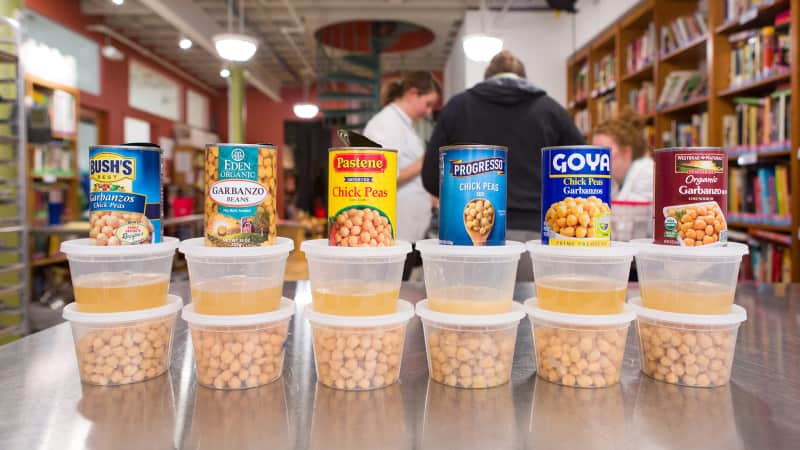Supermarket Hummus
Taste Test
When it comes to choosing canned chickpeas, the secret’s in the salt.
Published Jan. 1, 2018. Appears in America's Test Kitchen TV Season 19: Falafel and Harira

If you don’t already consider chickpeas (also called garbanzo beans) a pantry staple, you should. They’re incredibly versatile, as at home in Italian pasta dishes and vegetable soups as they are in Indian curries and Middle Eastern hummus. We use them plain or crisp them on the stovetop with oil and salt to add crunch to salads and snacks. A few years ago, we started using the starchy bean liquid, called aquafaba (which we had previously poured down the sink), to add flavor and body to chickpea soups and stews. More recently, that liquid has gained traction as a vegan egg replacement in foods that don’t contain any chickpeas at all, such as meringues and muffins (see “Using Aquafaba for Egg-Free Meringues”). Now that we’re using chickpeas more frequently and in more varied applications, we thought they deserved a closer look.
Although we like dried chickpeas, we focused our attention on canned products because they’re widely available and don’t require hours of soaking and cooking. We’ve also found in past tests that the quality of canned beans can be quite good. We purchased six products, all nationally available, in 14- to 16-ounce cans. We started by tasting them plain and pureed into homemade hummus; in these tests, we first drained and rinsed the chickpeas and patted them dry. Then, to evaluate how the chickpeas fared when heated and to see if the bean liquids affected the consistency of finished recipes, we simmered the entire contents of two cans of each product in our Pasta e Ceci. At each tasting, our panel evaluated the chickpeas’ flavor, texture, and overall appeal.
It’s no secret that salt adds flavor. Two of the products had fairly low sodium levels—just 30 and 125 milligrams per ½-cup serving, which includes the bean liquid. One of these eschews salt for kombu seaweed, which the manufacturer said enhances the flavor of the chickpeas and softens them. Both products had a hint of “nutty,” slightly “sweet” chickpea flavor. But these “mild” chickpeas were easily overwhelmed by other ingredients. We can certainly add extra salt to hummus, but it’s trickier to season the actual chickpeas.
In pasta, even after simmering with pancetta and aromatics, the lowest-sodium chickpeas still tasted “bland.” Four products with much higher sodium levels, between 280 and 470 milligrams per ½ cup, were far more flavorful. In each application, higher levels of sodium enhanced the chickpeas’ natural flavors. In addition to the sweet, nutty flavors tasters noticed in the lower-sodium products, these saltier chickpeas tasted pleasantly “vegetal” and even “grassy.” Even the hummus had “strong chickpea flavor.”...
The mission of America’s Test Kitchen Reviews is to find the best equipment and ingredients for the home cook through rigorous, hands-on testing.

Kate is a deputy editor for ATK Reviews. She's a culinary school graduate and former line cook and cheesemonger.

This is a members' feature.